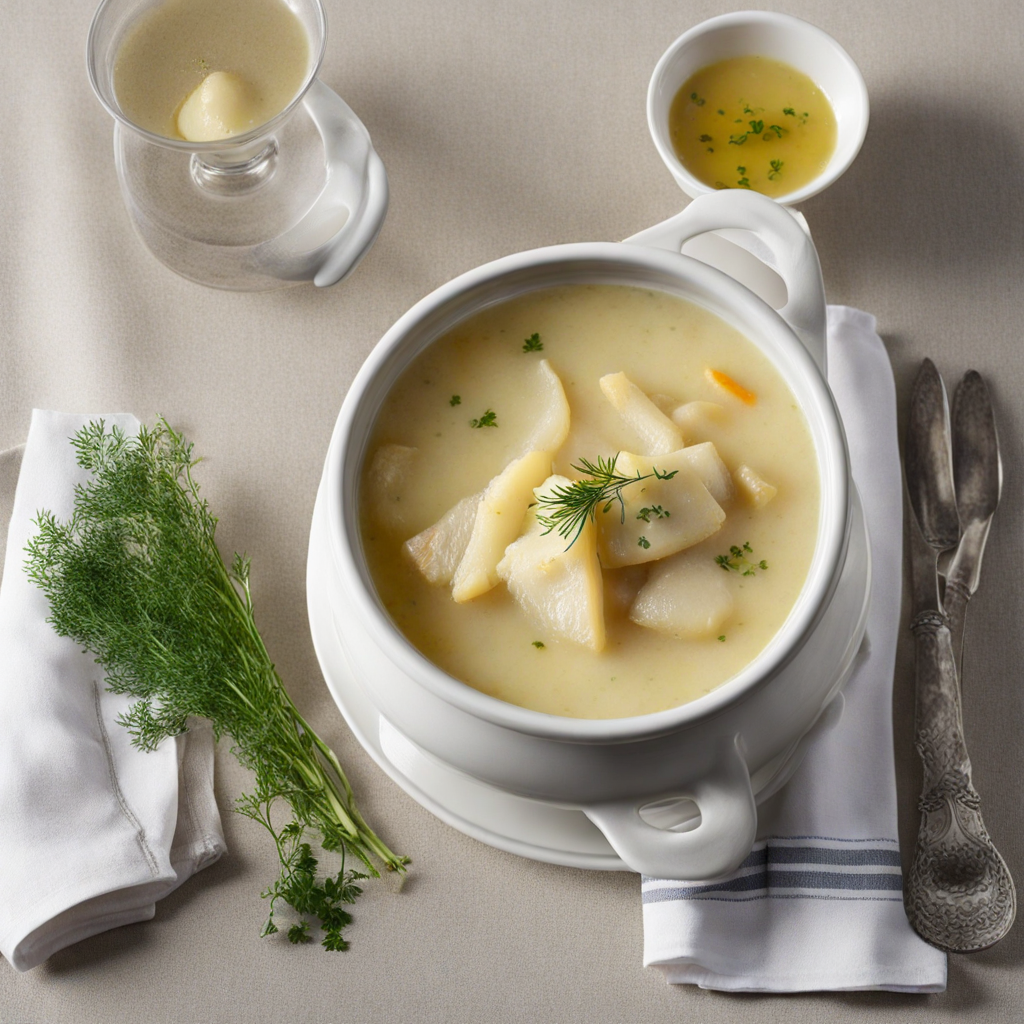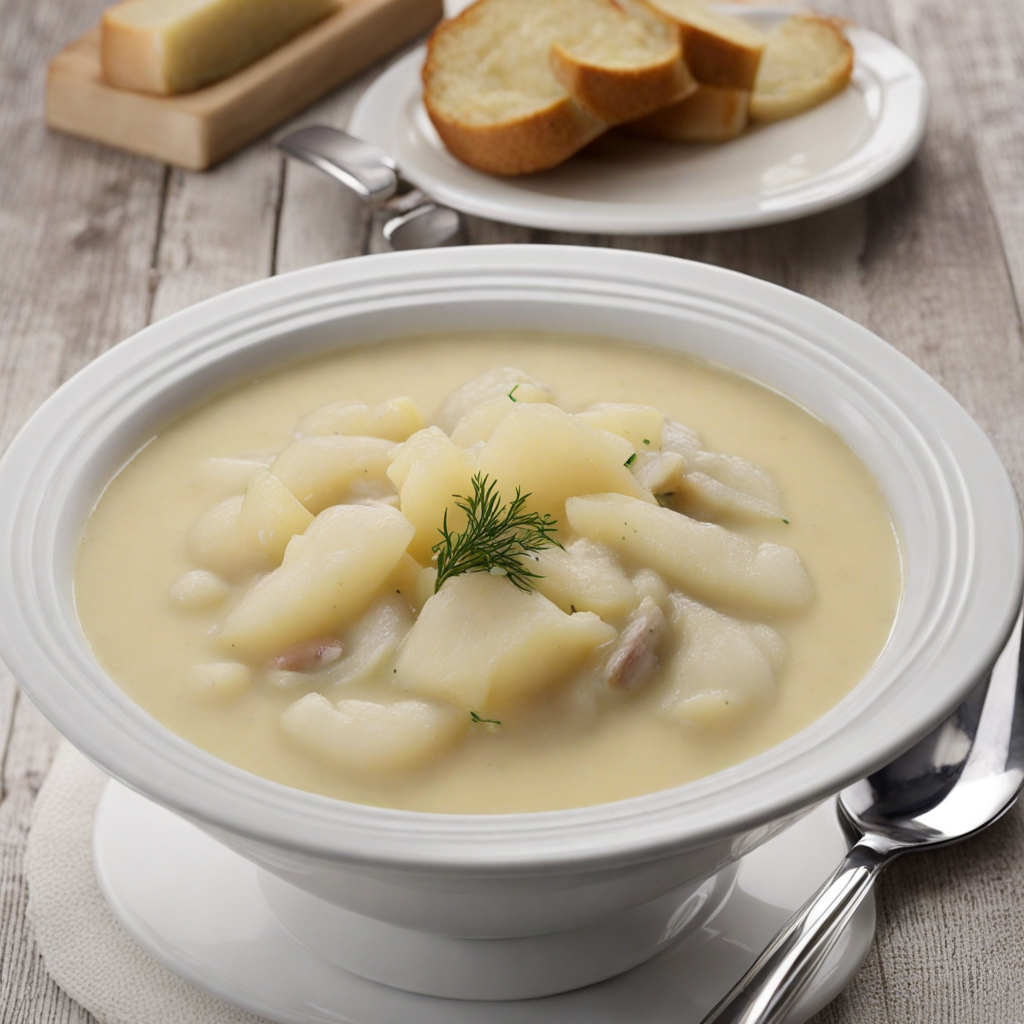Cullen Skink
Cullen Skink is a traditional Scottish soup that captivates the palate with its rich, smoky flavors and creamy texture. Originating from the town of Cullen in Moray, this dish is primarily made with smoked haddock, potatoes, and onions, creating a warm and comforting meal that reflects the coastal heritage of Scotland. The smokiness of the haddock infuses the soup with depth and complexity, while the potatoes add heartiness, making it a perfect dish for chilly days. The preparation of Cullen Skink begins with gently simmering the smoked haddock to extract its flavors, often accompanied by onions that are sautéed to develop their natural sweetness. As the fish cooks, the broth transforms into a flavorful base that is further enriched with the addition of potatoes, which are diced and cooked until tender. A splash of cream is typically added at the end, enhancing the soup's luxurious mouthfeel and creating a delightful contrast to the savory notes of the smoked fish. Served hot, Cullen Skink is often garnished with fresh herbs, such as parsley or chives, which elevate its presentation and add a hint of freshness. This dish not only offers a unique taste of the Scottish culinary tradition but also showcases the use of local ingredients, making it a beloved comfort food. Whether enjoyed as a starter or a main course, Cullen Skink promises a satisfying experience that invites you to savor the rich flavors of Scotland's coastal cuisine.
How It Became This Dish
Cullen Skink: A Culinary Journey Through Time #### Origin and Early Beginnings Cullen Skink is a traditional Scottish soup that hails from the small town of Cullen in Moray, on the northeast coast of Scotland. Its roots can be traced back to the 19th century, although some arguments suggest that similar fish soups could have existed even earlier in the region. The name "Cullen Skink" itself reflects the dish's geographical and cultural heritage: "Cullen" refers to the town, while "skink" is derived from the Scots word for "broth" or "soup," particularly one made with meat or fish. The primary ingredients of Cullen Skink include smoked haddock, potatoes, onions, and cream, which together create a rich, hearty soup that exemplifies the culinary traditions of coastal communities. The use of smoked haddock is particularly significant, as fishing has long been a vital part of the economy and culture of the Moray Firth area. The local fishermen would smoke the fish to preserve it, a practice that not only extended the shelf life of the catch but also imparted a distinctive flavor that would become synonymous with the soup. #### Cultural Significance Cullen Skink occupies a special place in Scottish culinary heritage. It is more than just a dish; it embodies the spirit and resourcefulness of the Scottish people, particularly those living in coastal regions. The soup reflects the community's connection to the sea, showcasing the availability of local ingredients and the importance of seasonal cooking. In the past, Cullen Skink was often served as a humble meal for the working class, made with ingredients that were readily available and affordable. However, its popularity has grown over the years, and it is now regarded as a delicacy, celebrated in restaurants and homes alike. The dish's transition from a simple, rustic meal to a staple of Scottish cuisine illustrates the changing perceptions of traditional foods and their ability to adapt to modern tastes. Cullen Skink has also earned a place in cultural celebrations and events. It is often featured in local festivals, food fairs, and even national competitions. Its presence in these gatherings underscores its importance as a symbol of regional pride and culinary identity. Moreover, the soup has become a source of nostalgia for many Scots, evoking memories of family gatherings, cozy dinners, and the warmth of home-cooked meals. #### Development Over Time As the culinary world has evolved, so has Cullen Skink. Traditional recipes have seen various adaptations, with chefs and home cooks experimenting with new ingredients and techniques while still honoring the dish's heritage. While the classic version remains beloved, modern interpretations sometimes incorporate additional elements such as leeks, carrots, or even different types of fish, broadening the flavor profile and making it accessible to a wider audience. The rise of the farm-to-table movement and a renewed interest in local, sustainable foods have also influenced the preparation of Cullen Skink. Many chefs now emphasize the importance of sourcing ingredients from local suppliers, reinforcing the dish's connection to the Moray region. This trend not only supports local economies but also allows diners to experience the freshest flavors that the area has to offer. In recent years, Cullen Skink has gained recognition beyond Scotland, finding its way onto menus in fine dining establishments and gastro pubs across the UK and even internationally. Food writers and bloggers have taken notice, sharing their own takes on the dish and contributing to its growing popularity. This newfound attention has led to a revival of traditional recipes, as well as the creation of innovative variations that reflect contemporary culinary trends. #### A Culinary Icon Today, Cullen Skink is celebrated as a culinary icon of Scotland, a dish that beautifully marries simplicity with depth of flavor. The rich, creamy broth, complemented by the smokiness of the haddock and the earthiness of the potatoes, creates a comforting and satisfying experience that speaks to the heart of Scottish cuisine. It is often served with crusty bread or oatcakes, allowing diners to savor every drop of the delicious soup. Cullen Skink's prominence in Scottish culture has also inspired various culinary initiatives and competitions aimed at preserving traditional recipes. Organizations dedicated to promoting Scottish food heritage have worked to ensure that the story of Cullen Skink continues to be told, encouraging new generations to appreciate and carry on this culinary tradition. #### Conclusion Cullen Skink is more than just a soup; it is a reflection of Scotland's rich culinary heritage, a testament to the resourcefulness of its people, and a symbol of regional pride. Its evolution from a humble, rustic dish to a celebrated culinary icon illustrates the dynamic nature of food and culture. As we continue to explore the flavors and stories behind our meals, Cullen Skink serves as a delicious reminder of the importance of tradition, community, and the simple joys of good food. Through its warmth and heartiness, Cullen Skink invites all who partake to share in its history, fostering connections between generations and celebrating the enduring spirit of Scottish cuisine. Whether enjoyed on a cold winter's day or as part of a festive gathering, Cullen Skink remains a beloved dish that captures the essence of Scotland's culinary landscape, ensuring its place in the hearts and kitchens of many for years to come.
You may like
Discover local flavors from United Kingdom







